Although nurseries and garden centers sell a plethora of beautiful succulents, many plant lovers eventually get to a point where they want to add some rare and unusual pieces to their plant collection. The following list discusses some of my favorite rare succulents. I consider these succulents rare because they are not typically sold at big box stores or nurseries. In general, you have to purchase these plants online or at a specialty nursery.
1. Euphorbia obesa
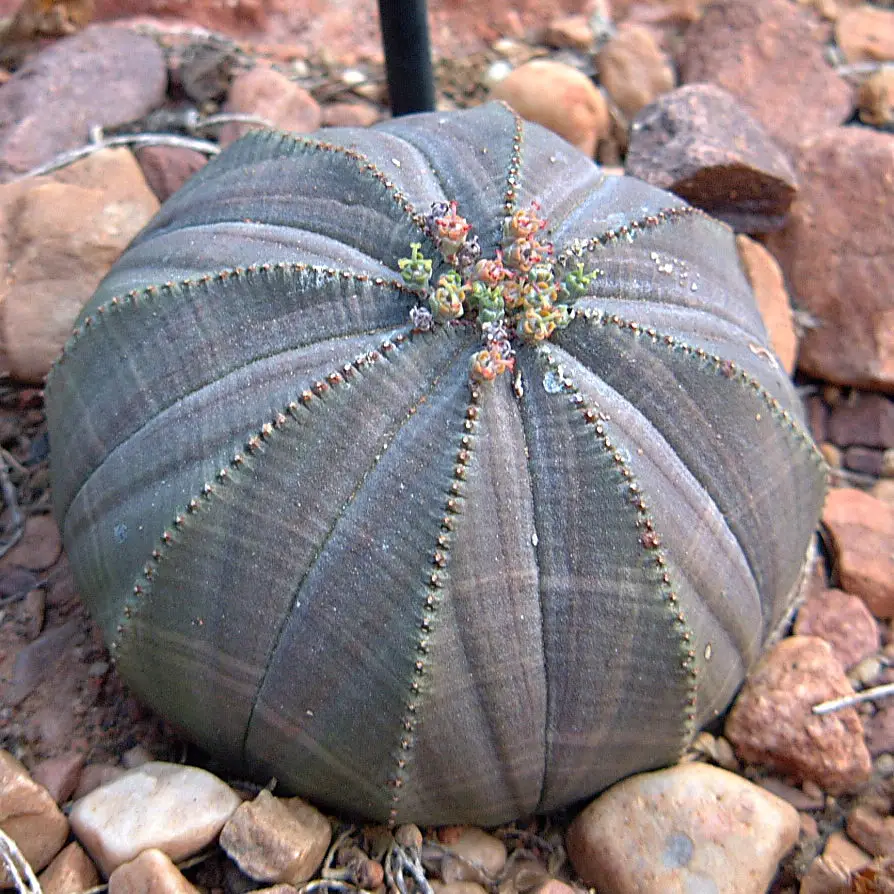
Eurphorbia obesa, which is commonly referred to as Sea Urchin Plant or Baseball Plant, is an odd-looking succulent native to the Eastern Cape of South Africa. It is a single-stemmed, firm-bodied succulent. They can grow to a height of about 11 inches. Younger plants have a more rounded appearance, but they develop a more elongated shape as they get older.
Interestingly, Euphorbia obesa is a dioecious species, which means that the male and female flowers develop on different plants. Less than 10% of angiosperms (flower plants) are dioecious.
Unfortunately, over-collecting almost caused this plant to go extinct. Fortunately, Euphorbia obesa is now protected by CITES. Although this plant is rare in its native habitat, it is fairly well-established in cultivation.
Like all succulents, this plant should be placed in a spot that is exposed to bright, indirect light. It should also be planted in a sandy or gravely shale-based soil.
2. Conophytum subglobosum

Like Euphorbia obesa, Conophytum subglobosum is native to the South Africa. However, it is endemic to the Western Cape rather than the Eastern Cape. Conophytum subglobosum are commonly referred to as Living Pebbles, and they belong to the same family as Lithops (though they are not Lithops).
In the wild, these succulents are winter growers that are found in rock crevices along with other shade-loving plants such as mosses and lichens. Conophytum subglobosum is generally found on east, south, or west-facing rock faces. They will bloom in October or November.
This plant was first described in the British Cactus and Succulent Society’s Cactus Journal in 1937. This species was discovered by Dr. Margaret Levyns, a prominent South African botanist and taxonomist.
Plant these succulents in soil that drains well and place it in a location that receives plenty of sunlight. You do not need to water these plants very frequently. In the wild, they can go months without water.
3. Haworthia cooperi
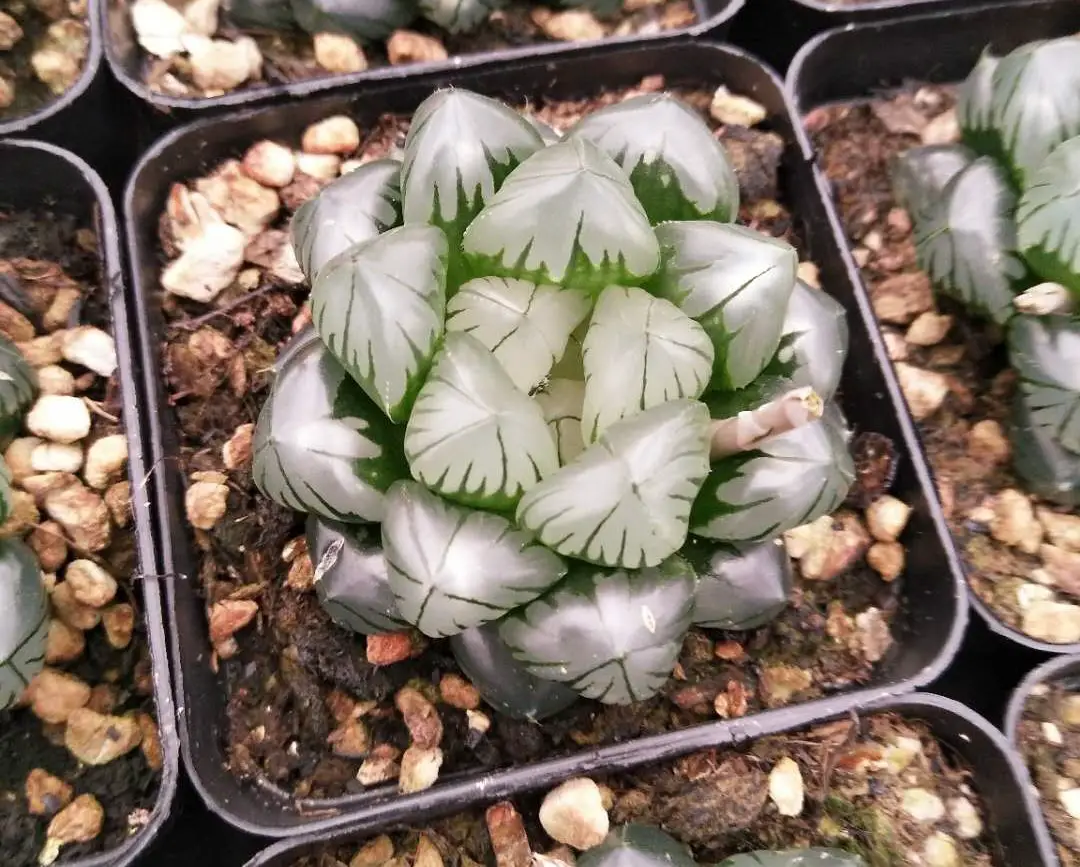
Haworthia cooperi, which is commonly referred to as Window Haworthia, is a low-growing succulent that has translucent leaves. This plant is unique in that a significant portion of the plant is buried. The leaves growing above ground actually transport light to the leaves underground. The buried leaves then perform photosynthesis.
There are a number of varieties or sub-species of Haworthia cooperi, and these varieties do vary significantly in appearance.
Like other Haworthias, this succulent tends to be a winter grower. For this reason, it is important to limit watering during the summer months in order to minimize the chance of root rot.
This species is one of the more commonly available succulents on this list. You may even see it big box stores every once in a while. In general, these plants have care requirements that are typical of succulents. However, it is extremely important that you allow your plant to acclimate to brighter light locations. You can do this by placing several pieces of tissue paper on top of the plant. Every couple of days, remove a layer of tissue paper.
To learn more about how to care for Haworthia cooperi succulents, check out this article I wrote.
4. Tephrocactus articulatus var. papyracanthus
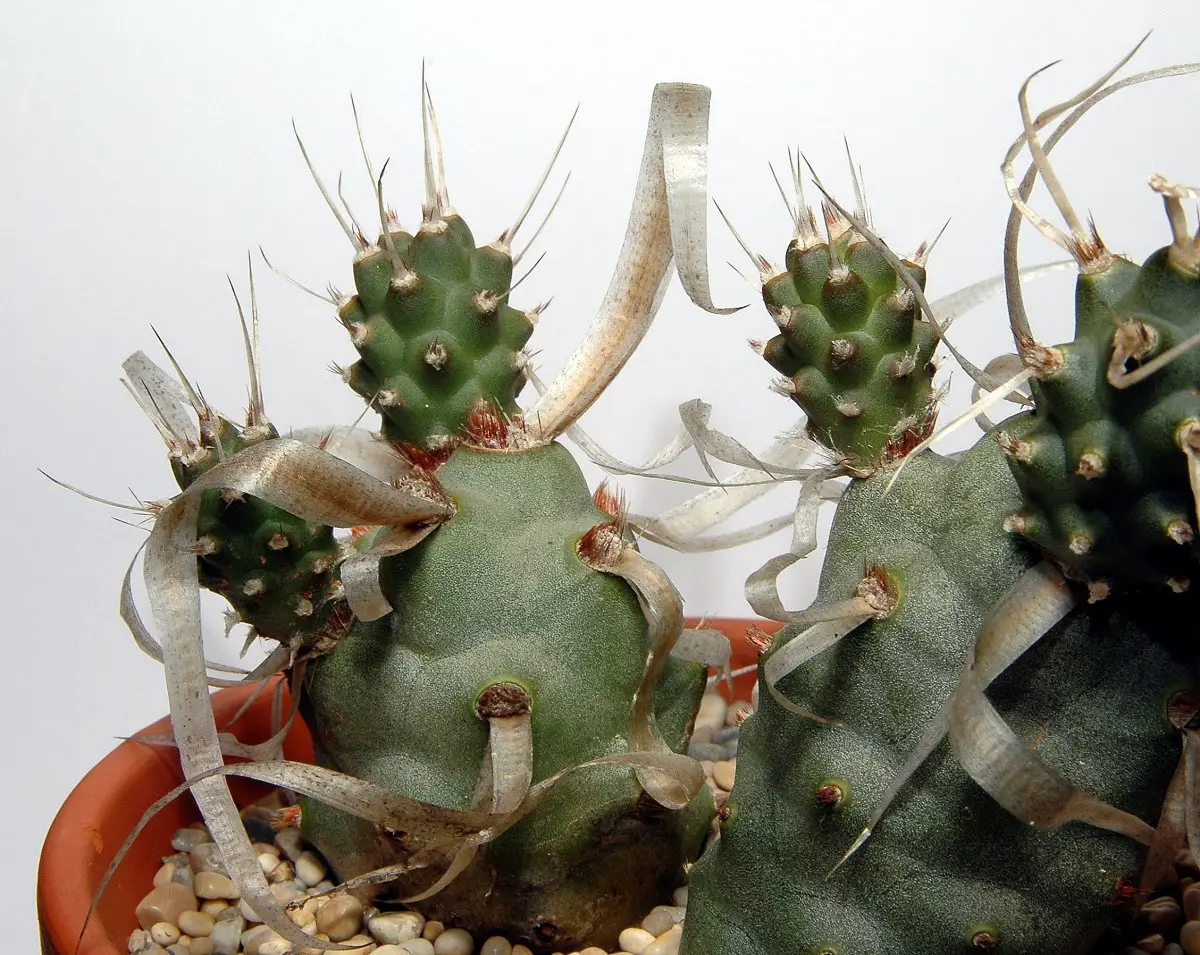
Tephrocactus articulatus, which is commonly known as Paper Spine Cactus, is native to Argentina. These plants are slow-growing, but they can produce branches up to one foot in length. These cacti have unique spines that look like strips of paper. Paper Spine Cactus is a flowering plant that produces white flowers.
Although it is possible to grow these plants indoors, they tend to do better when grown outdoors in USDA Hardiness Zones 8b to 10b. However, they should be brought indoors before the first frost.
This species is variable as to whether it is spine-bearing. The variety of this plant that bears the paper-like spines is papyracanthus. Paper Spine Cactus produces yellow or white flowers. After flowering, the plant will produce a brown fruit.
Tephrocactus articulatus can be propagated via seeds or stem cuttings.
5. Haworthia truncata var. maughanii
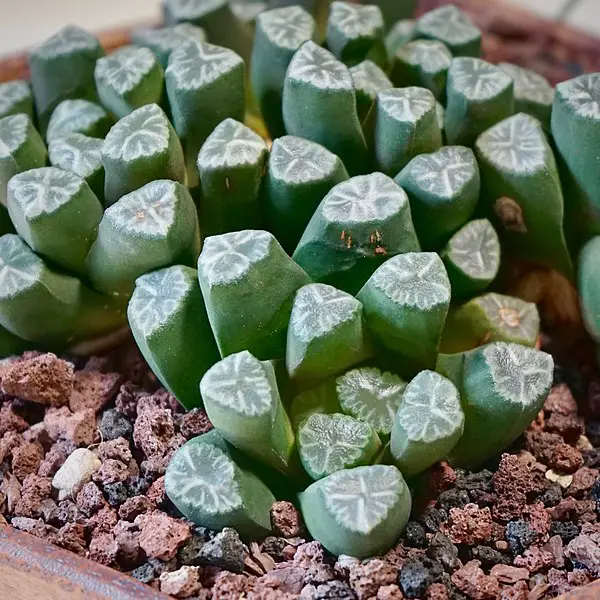
Haworthia truncata var. maughanii, which is commonly called Maughan’s Haworthia, is a sub-species of Haworthia truncata that has flat tops. It is endemic to the Western Cape of South Africa and grows in the shade of bushes. Occasionally, you will find them in open areas.
Like Haworthia cooperi, a significant portion of this plant’s leaves are buried underground. This protects the plant because animals cannot eat the entire leaf.
Originally, Haworthia truncata var. maughanii was named Haworthia maughanii. However, due to their closeness, scientists grouped Haworthia truncata and Haworthia maughanii into one species.
Like other species belonging to the Haworthia genus, Haworthia truncata var. maughanii produces small flowers that are white and pale lavender. In the wild, these succulents bloom during late spring or summer. However, they may bloom during other parts of the year in cultivation.
6. Astrophytum asterias
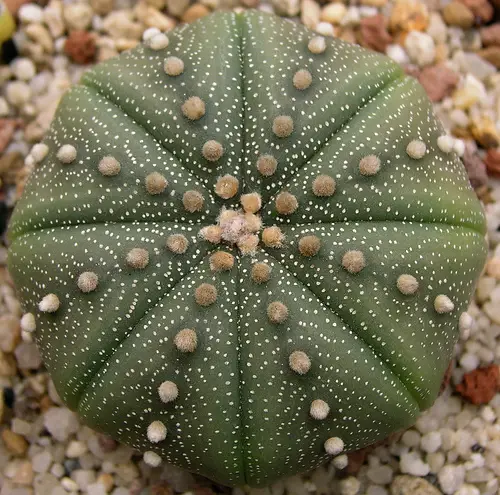
Astrophytum asterias is a species of cactus that is native to parts of Texas and Mexico. It is commonly referred to as the Sand Dollar Cactus, Sea Urchin Cactus, Star Cactus, or Star Peyote.
This cactus blooms between March and June in its native habitat. After blooming, Astrophytum asterias produces fruit that looks very similar to the fruit produced by Euphorbia obesa.
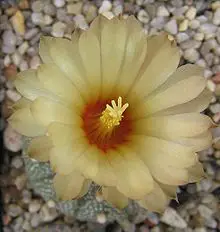
This cactus has been grown as a houseplant since the 1840s. Unfortunately, over-collecting has become a significant threat to the survival of this slow-growing species.
The United States Fish and Wildlife Service has classified Astrophytum asterias as an endangered species. According to a recovery plan published by the United States Fish and Wildlife Service in October of 2002, a minimum of 2,000 Astrophytum asterias plants are to be grown on a protected portion of Federal Land in Texas.
Astrophytum asterias is also listed in Appendix I of the Convention on International Trade in Endangered Species of Wild Fauna and Flora (CITES) list meaning that international trade of this species is prohibited.
7. Lapidaria Margaretae
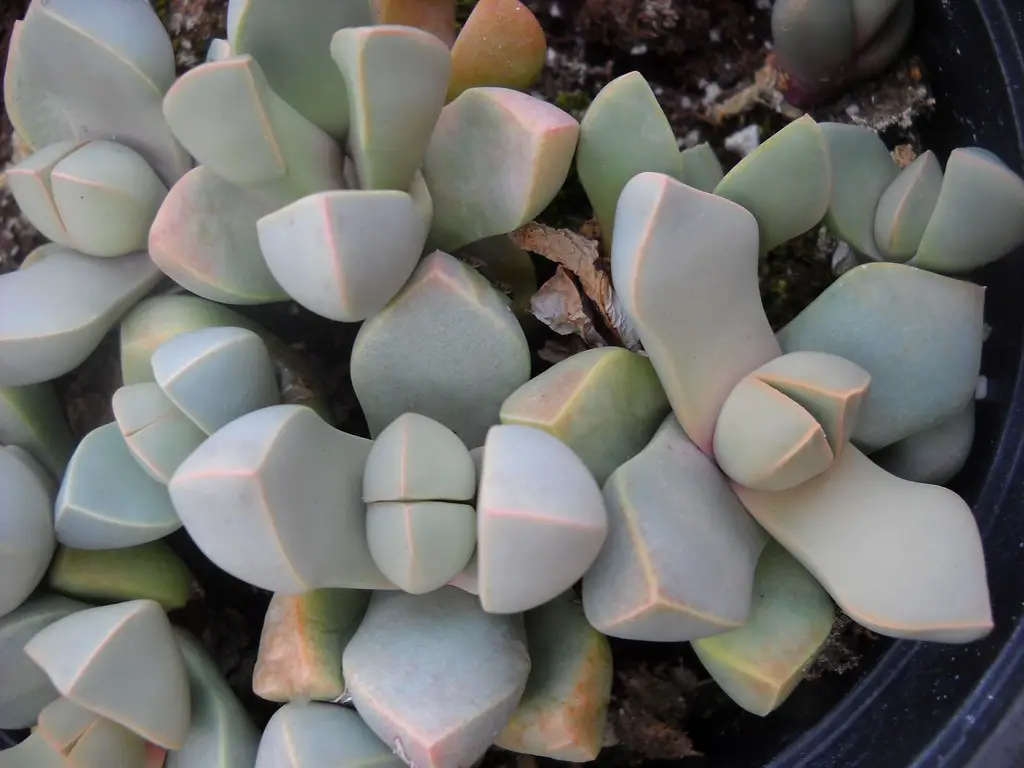
Lapidaria Margaretae, which is also referred to as Karoo Rose, is a dwarf succulent species belonging to the Aizoaceae family. These plants are closely related to Lithops. However, Lithops tend to have one pair of leaves while Lapidaria Margaretae have two to four pairs of leaves.
These succulents produce large yellow flowers during the fall. Lapidara Margaretae goes dormant during the cold winter months and the hot summer months.
Like Lithops, these plants grow best in gritty soil. They also require exposure to bright light. It is important to not overwater these plants as they will take up excess water and split within a day of being overwatered. When in doubt, err on the side of underwatering.
Unfortunately, these plants have a tendency to die if the conditions are not quite right, so it is important to make sure to pay close attention to this plant’s care requirements.
8. Sinocrassula yunnanensis
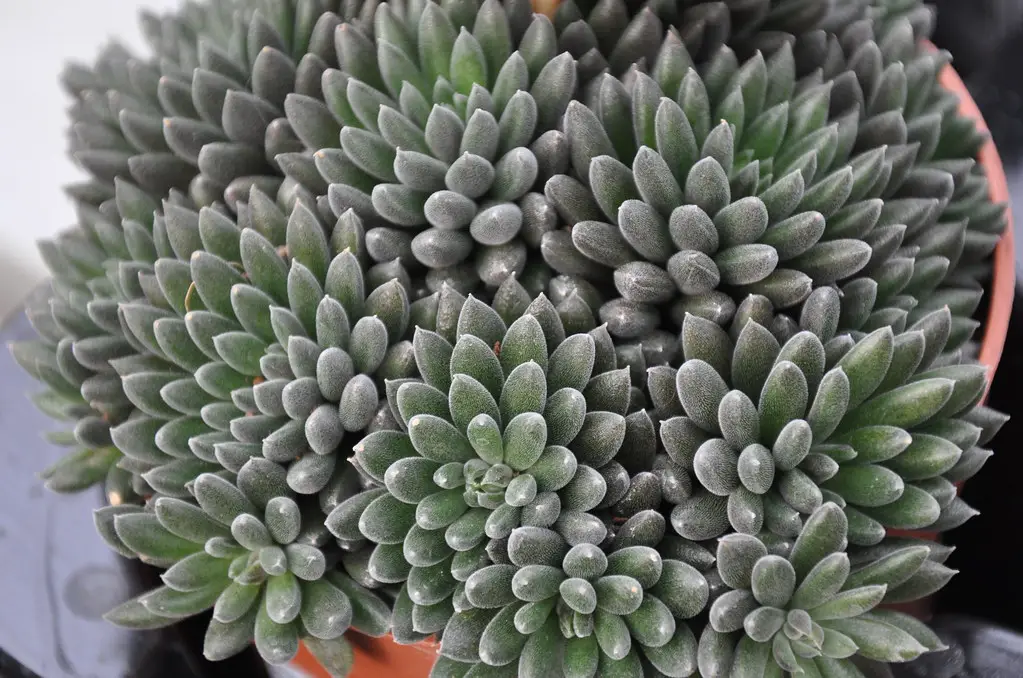
Sinocrassula yunnanensis, which is commonly referred to as the Chinese Jade, is a low-growing succulent that eventually grows into clumps. This species of succulent develops a dark (almost black in some cases) colors which give it a striking appearance.
Sinocrassula yunnanensis is native to Yunnan Province in southwestern China. They grow at high elevations (2,500 to 2,800 meters). In the wild, these plants tend to grow in rock crevices.
Chinese Jade grows well in rock gardens as well as in containers with gravely soil. They like dry conditions and can survive off the water stored in their leaves for extended periods of time. Like other succulents, this plant is susceptible to root rot from overwatering. This plant requires exposure to plenty of sunlight. If it does not receive enough sunlight, this plant will lose its dark, vibrant color.
Sinocrassula yunnanensis is a moncarpic plant that produces little white flowers. This means that it will flower once and die. Fortunately, this plant grows in clumps, so dead rosettes are quickly replaced with other rosettes.
This succulent can be difficult to find in the United States, but it is very popular in Japan and parts of Asia.
9. Kalanchoe figuereidoi
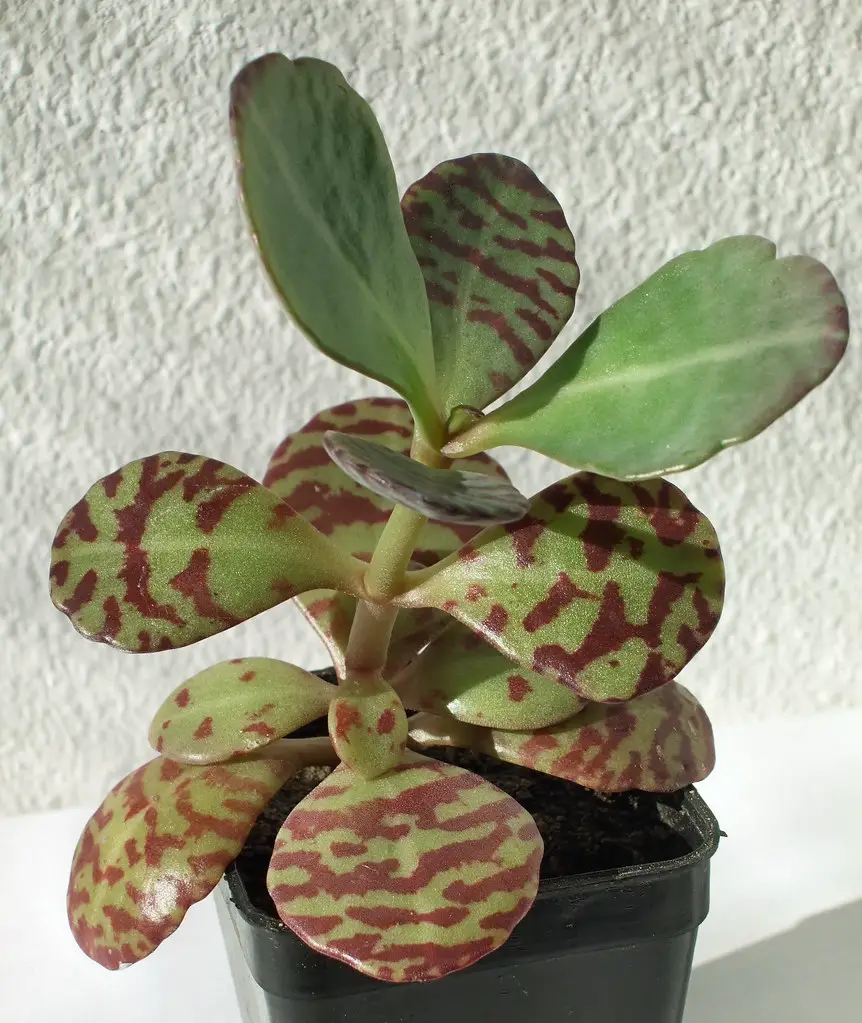
Kalanchoe figuereidoi is a plant species that belongs to the Crassulaceae family and can grow up to 3.3 feet (1 meter) in height.
In the wild, Kalanchoe figuereidoi grows in between rocks in the Southern Province of Tanzania at elevations between 1,200 and 1,410 meters (Raadts, 1977).
This succulent is often confused for Kalanchoe humilis. Kalanchoe humilis has fewer spots than Kalanchoe figuereidoi and is from Madagascar.
Kalanchoe figuereidoi grows well in clay pots with well-draining soil. To improve drainage, add perlite to your soil mix. These plants do not tolerate cold temperatures very well. For this reason, you should avoid placing your Kalanche figuereidoi near drafty doors or windows.
10. Stenocactus multicostatus
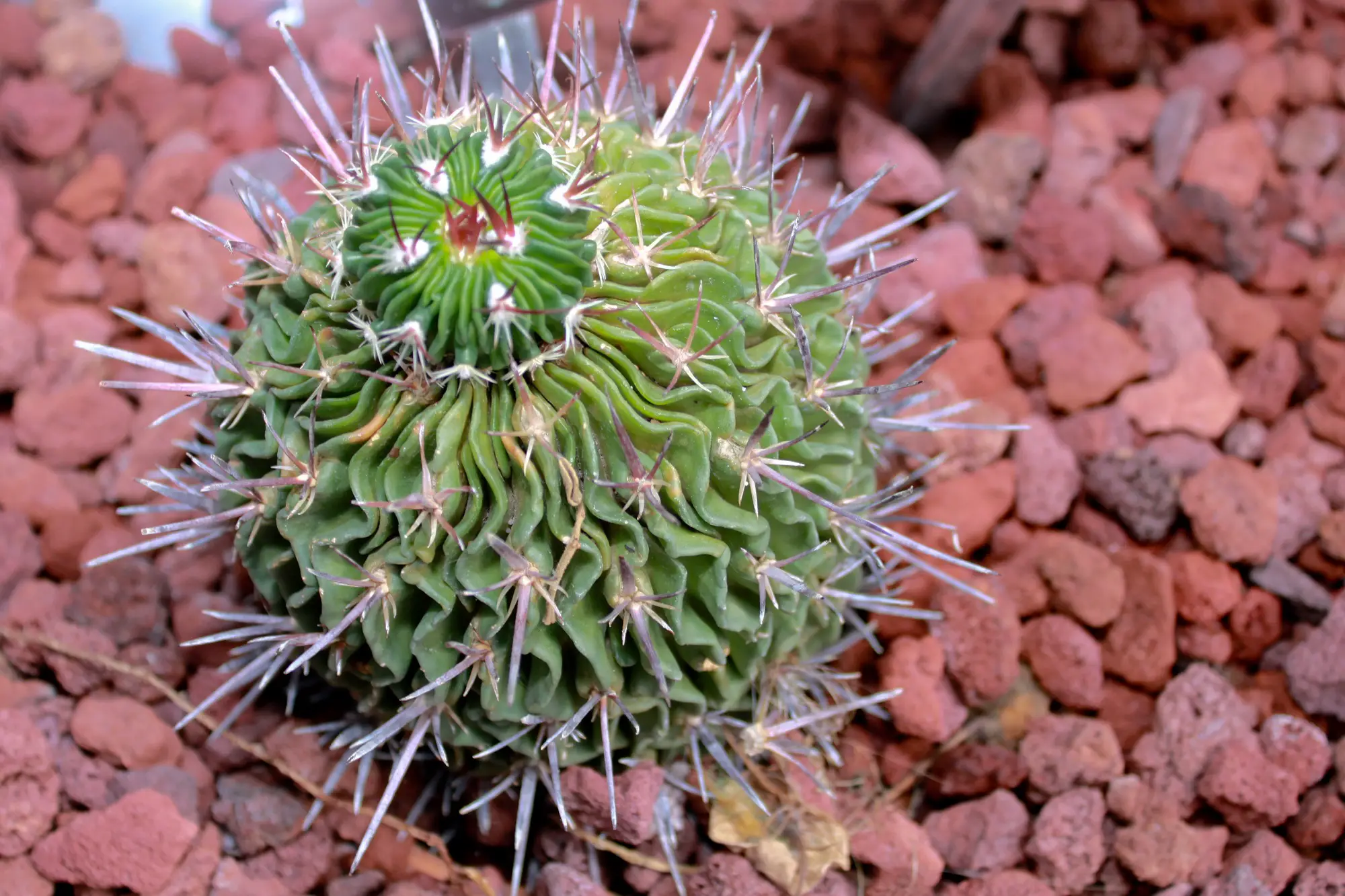
Stenocactus multicostatus, which is commonly known as Brain Cactus or Brain Plant, has a unique appearance that makes it an excellent addition to any cactus lover’s collection. Due to its complex nomenclature history, you may also see this species referred to as Echinofossulocactus multicostatus.
This cactus is native to the Chihuahuan Desert in Mexico and stays small throughout its entire growing cycle. There is a significant amount of variation in the species with each plant having a different spinal pattern, number of ribs, and body shape. Brain Cactus produces flowers that are about 1 inch in diameter and have a pinkish or purple hue. Typically, these plants bloom during the spring or summer seasons.
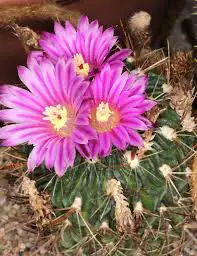
These plants can grow outdoors in USDA Hardiness Zones 9b – 11. Like other cacti, Brain Cactus needs plenty of sunlight. They do well if they are exposed to some direct sunlight. Allow the soil to dry out completely between watering sessions. It is extremely important to make sure that these plants do not sit in moisture for extended periods of time.
11. Kalanchoe laetivirens
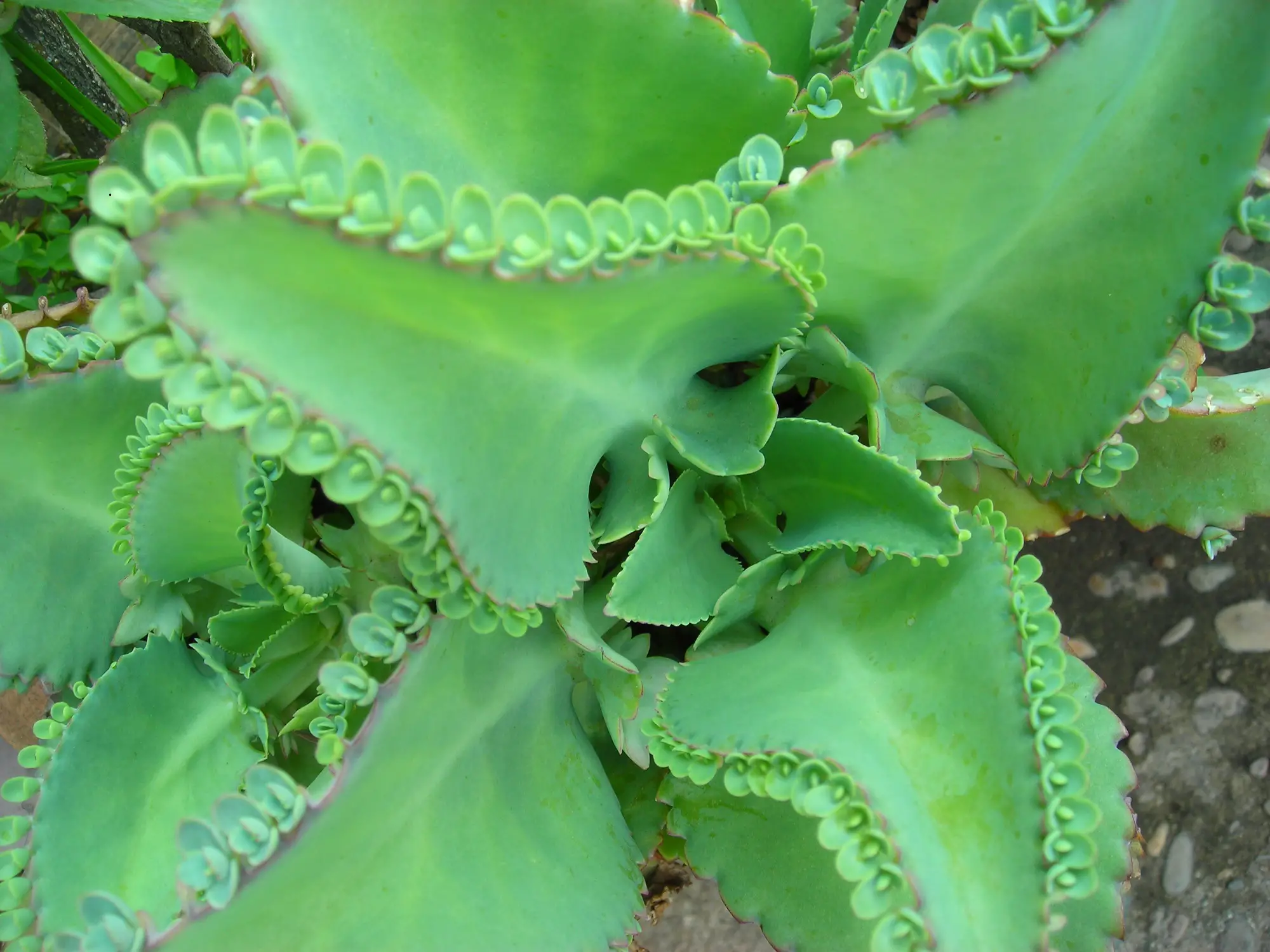
Kalanchoe laetivirens, which is commonly known as Mother of Thousands or Mother of Millions, is native to Madagascar. It is an unusual succulent that grows plantlets around the edges of its leaves. During the early spring, it will bloom pink bell-shaped flowers. These beautiful flowers are long-lasting.

Source: Reddit User sucsforyou
These succulents are not particularly fussy, but they should be grown in gritty, well-draining soil. Kalanchoe laetivirens can be grown outdoors in USDA Hardiness Zones 9a through 11b and do best in partial sun. Intense southern light can burn the edges of the leaves. If they are grown indoors, these plants will do well near a south-facing window during the wintertime.
Kalanchoe laetivirens do need to be repotted every couple of years. Like other Kalanchoes, clay pots work well because the porous material allows the soil to dry out more quickly.
12. Corpuscularia lehmanii
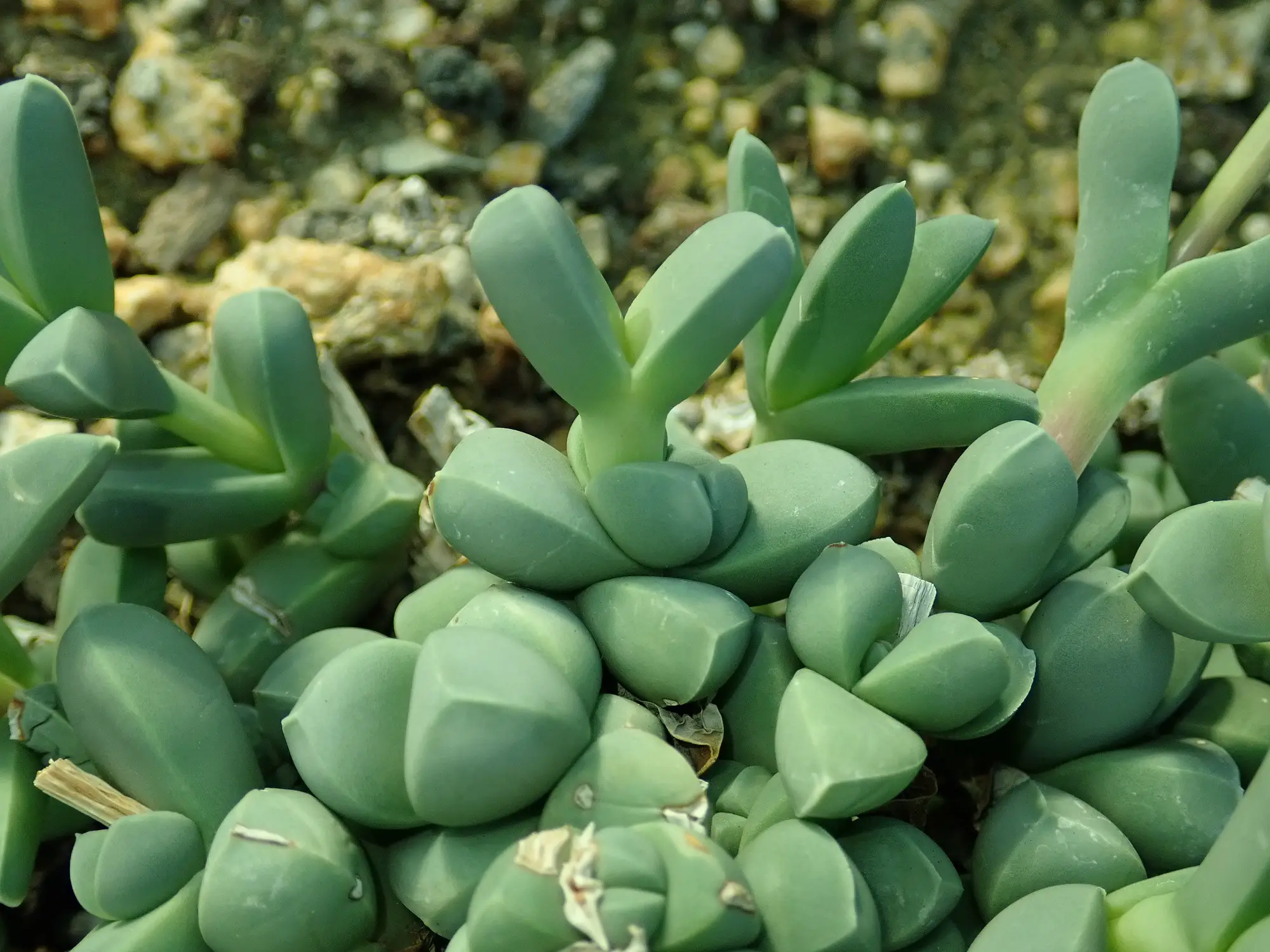
Corpuscularia lehmanii, which is commonly referred to as Ice Plant, is another unusual succulent that resembles Lithops. These succulents grow quickly and do well indoors. They can also grow outside in USDA Hardiness Zones 9a – 12. They are not tolerant of frost or cold temperatures.
When Ice Plant blooms, they produce a yellow flower.
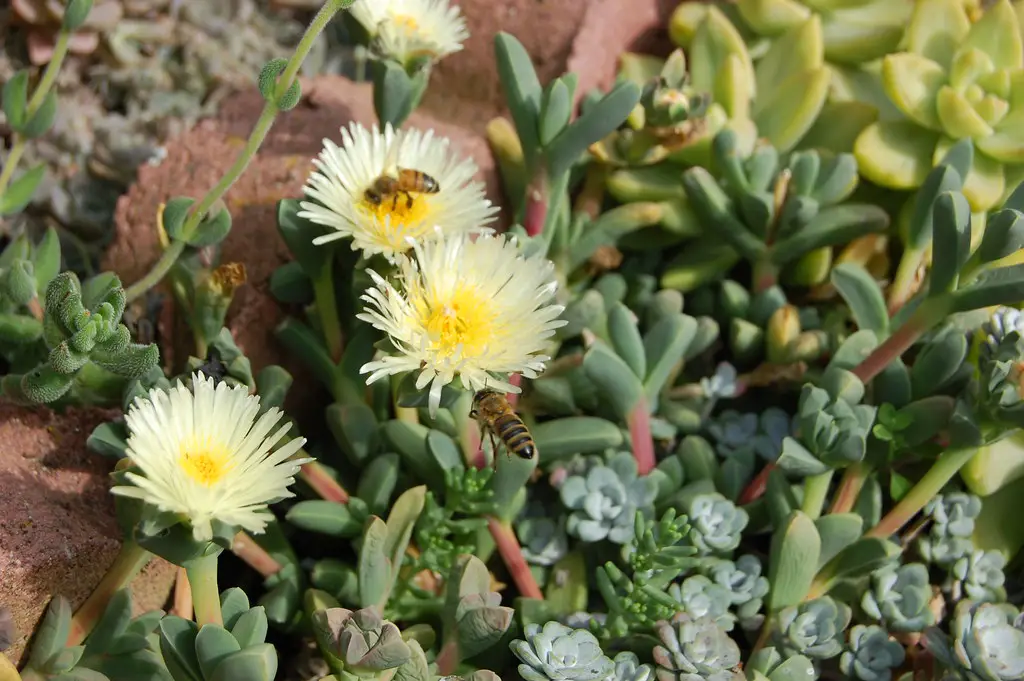
Like other succulents, Ice Plant should be placed near a sunny window when grown indoors. If these plants are not exposed to enough sunlight, they will lose their compact shape. When grown outdoors, these plants will do well in partial sun to full shade.
Ice Plant has watering needs that are similar to other succulents. Water the plant thoroughly and allow the soil to dry completely before watering again. These plants are a bit sensitive to under-watering and will wilt somewhat easily.
These plants can be propagated by cuttings, division, or by growing seeds. If you choose to propagate via division, it is best to divide these plants during the spring.
13. Albuca spiralis

Albuca spiralis, which is commonly known as Frizzle Sizzle, is a unique-looking succulent with coiled tips. Like many of the other succulents on this list, Frizzle Sizzle is native to South Africa. If cared for properly, this plant will produce yellow flowers during the spring that smell like vanilla and butter.
Frizzle Sizzle can be grown in USDA Hardiness Zones 8-10, and it requires a minimum temperature of 60°F. These plants can be grown indoors, but they do best when exposed to natural sunlight. Too little light can result in loosened twists at the top of the plant.
Albuca spiralis does not use as much water as many succulent species, but it is best to water before the soil dries out completely. Before watering, check to see if the soil surface is dry. If so, water the plant. Too little water can affect flower production. When the plant goes dormant during the summer months, do not water until you see new foliage.
14. Kalanchoe pink butterfly
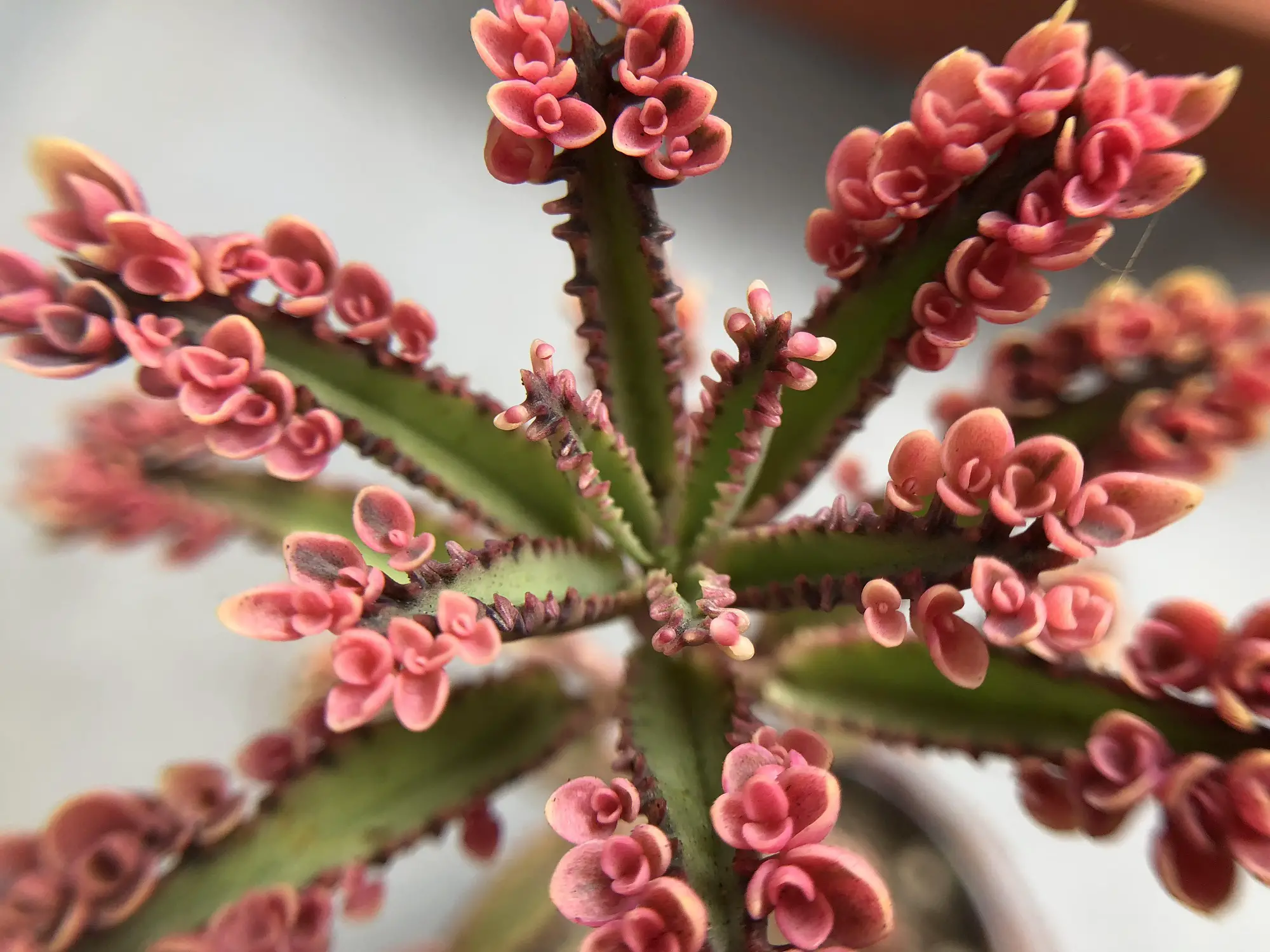
Source: Reddit User Britt-Christmas
Kalanchoe pink butterfly is a colorful type of succulent that is a colorful, variegated form of Kalanchoe x houghtonii. Like its parent plant, Kalanchoe pink butterfly contains plantlets around the edge of the leaves. Unlike the parent plant, Kalanchoe pink butterfly has lost its ability to propagate new plants from the plantlets growing around the leaf. This is because the plantlets lack chlorophyll (which is why they are pink in color).
This plant has care requirements that are very similar to Kalanchoe laetivirens (number 11 on this list). Intense southern light can burn the edges of the leaves. If they are grown indoors, these plants will do well near a south-facing window during the wintertime. Water these plants regularly during the summertime (allow the soil surface to dry between waterings). During the wintertime, the soil can dry out even more between waterings.
15. Crassula cv. ‘Morga’s Beauty’

Crassula cv. ‘Morgan’s Beauty’ is a cross between Crassula perfoliata and Crassula mesembryanthemopsis Both of these species are native to Southern Africa. It is comprised of a stack of silvery green leaves and blooms pink flowers.
In general, this plant will bloom during the winter or early spring. Like other Crassulas, this plant should be grown in porous soil that drains well. In the wild, Crassulas grow in rocky quartz fields.
You can propagate these plants by taking cuttings during the winter. Cutting the top off of your Crassula cv. ‘Morgan’s Beauty’ will make the plant appear fuller and prevents the clumps from rotting.
